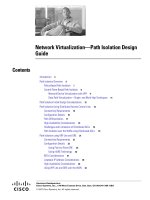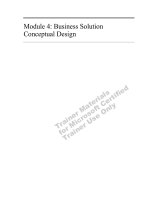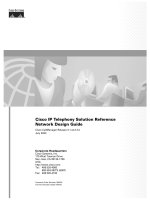Business Ready Teleworker Design Guide
Bạn đang xem bản rút gọn của tài liệu. Xem và tải ngay bản đầy đủ của tài liệu tại đây (3.4 MB, 260 trang )
Corporate Headquarters
Cisco Systems, Inc.
170 West Tasman Drive
San Jose, CA 95134-1706
USA
Tel: 408 526-4000
800 553-NETS (6387)
Fax: 408 526-4100
Business Ready Teleworker Design Guide
January 2004
Customer Order Number: OL-11675-01
THE SPECIFICATIONS AND INFORMATION REGARDING THE PRODUCTS IN THIS MANUAL ARE SUBJECT TO CHANGE WITHOUT NOTICE. ALL
STATEMENTS, INFORMATION, AND RECOMMENDATIONS IN THIS MANUAL ARE BELIEVED TO BE ACCURATE BUT ARE PRESENTED WITHOUT
WARRANTY OF ANY KIND, EXPRESS OR IMPLIED. USERS MUST TAKE FULL RESPONSIBILITY FOR THEIR APPLICATION OF ANY PRODUCTS.
THE SOFTWARE LICENSE AND LIMITED WARRANTY FOR THE ACCOMPANYING PRODUCT ARE SET FORTH IN THE INFORMATION PACKET THAT
SHIPPED WITH THE PRODUCT AND ARE INCORPORATED HEREIN BY THIS REFERENCE. IF YOU ARE UNABLE TO LOCATE THE SOFTWARE LICENSE
OR LIMITED WARRANTY, CONTACT YOUR CISCO REPRESENTATIVE FOR A COPY.
The Cisco implementation of TCP header compression is an adaptation of a program developed by the University of California, Berkeley (UCB) as part of UCB’s public
domain version of the UNIX operating system. All rights reserved. Copyright © 1981, Regents of the University of California.
NOTWITHSTANDING ANY OTHER WARRANTY HEREIN, ALL DOCUMENT FILES AND SOFTWARE OF THESE SUPPLIERS ARE PROVIDED “AS IS” WITH
ALL FAULTS. CISCO AND THE ABOVE-NAMED SUPPLIERS DISCLAIM ALL WARRANTIES, EXPRESSED OR IMPLIED, INCLUDING, WITHOUT
LIMITATION, THOSE OF MERCHANTABILITY, FITNESS FOR A PARTICULAR PURPOSE AND NONINFRINGEMENT OR ARISING FROM A COURSE OF
DEALING, USAGE, OR TRADE PRACTICE.
IN NO EVENT SHALL CISCO OR ITS SUPPLIERS BE LIABLE FOR ANY INDIRECT, SPECIAL, CONSEQUENTIAL, OR INCIDENTAL DAMAGES, INCLUDING,
WITHOUT LIMITATION, LOST PROFITS OR LOSS OR DAMAGE TO DATA ARISING OUT OF THE USE OR INABILITY TO USE THIS MANUAL, EVEN IF CISCO
OR ITS SUPPLIERS HAVE BEEN ADVISED OF THE POSSIBILITY OF SUCH DAMAGES.
Business Ready Teleworker Design Guide
Copyright © 2004 Cisco Systems, Inc. All rights reserved.
iii
Business Ready Teleworker Design Guide
OL-11675-01
CONTENTS
Preface
xi
Scope
xi
Target Audience
xii
Obtaining Documentation
xii
Cisco.com
xii
Documentation CD-ROM
xii
Ordering Documentation
xii
Documentation Feedback
xiii
Obtaining Technical Assistance
xiii
Cisco.com
xiii
Technical Assistance Center
xiv
Cisco TAC Website
xiv
Cisco TAC Escalation Center
xiv
Obtaining Additional Publications and Information
xv
CHAPTER
1
Business Ready Teleworker Design Guide Introduction
1-1
Solution Introduction
1-1
Solution Benefits
1-3
Business Ready Teleworker Benefits
1-3
V3PN Benefits for Business Ready Teleworkers
1-4
Service Provider Benefits
1-5
Solution Scope
1-5
Public and Private IP Addressing Conventions
1-6
Supporting Designs
1-6
CHAPTER
2
Business Ready Teleworker VPN Solution Overview
2-1
Solution Characteristics
2-2
General Best Practices Guidelines
2-2
Basic Guidelines
2-3
Quality of Service Guidelines
2-3
IPSec VPN Guidelines
2-4
Security Guidelines
2-4
General Solution Caveats
2-5
Basic Caveats
2-5
Contents
iv
Business Ready Teleworker Design Guide
OL-11675-01
QoS Caveats
2-6
IPSec VPN Caveats
2-6
Security Caveats
2-6
Solution Technology Components
2-7
Virtual Private Networks
2-7
IP Telephony
2-9
Small Office/Home Office
2-10
General Deployment Models
2-11
Integrated Unit
2-12
Dual Unit
2-12
Integrated Unit + Access Device
2-13
Which Model to Choose
2-14
Broadband Access Technologies
2-15
Digital Subscriber Line
2-15
Cable
2-16
Integrated Services Digital Network
2-16
Broadband Encapsulation
2-17
Choosing Broadband Access
2-18
CHAPTER
3
Business Ready Teleworker CPE Deployment Models
3-1
Devices Used for Models
3-3
CPE Selection Criteria and Recommendations
3-7
CHAPTER
4
Business Ready Teleworker Deployment Guidelines
4-1
Basic Services
4-1
One Broadband Connection
4-1
Ethernet Connection for Four or More SOHO Devices
4-2
Dynamic Host Configuration Protocol Support
4-2
Network Address Translation
4-4
Network Time Protocol and Simple Network Time Protocol
4-6
Enterprise-based Telephony Services
4-6
Quality of Service
4-8
General
4-8
CPE Performance
4-8
End-to-End QoS
4-9
Access Circuit QoS
4-10
QoS Classification Persistence through VPNs
4-11
IPSec VPN and Security
4-12
Technique for Strong Encryption
4-12
Contents
v
Business Ready Teleworker Design Guide
OL-11675-01
Packet Authentication Options
4-12
VPN Network Design
4-13
VPN Authentication
4-14
Per-User Authentication
4-16
Authentication Proxy
4-17
802.1X for VPN Access Control
4-20
Context-Based Access Control
4-29
Firewall Options
4-29
Split Tunneling
4-30
Two-Teleworker Homes
4-32
IP Multicast
4-35
In-Home Wireless
4-35
Improved Availability
4-37
Management
4-38
Basic Device Provisioning
4-38
Provisioning IPSec VPN
4-39
Provisioning Authentication
4-41
Policy and Device Management
4-41
Service Provider Managed Services
4-42
Ongoing Solution Creation for Provisioning
4-43
CHAPTER
5
V3PN for Business Ready Teleworker Solution Overview
5-1
Teleworker Applications Overview
5-1
Solution Characteristics
5-4
General Best Practices Guidelines
5-5
General Solution Caveats
5-5
CHAPTER
6
V3PN for Business Ready Teleworker Broadband Issues
6-1
Avoid Known Issues
6-1
Link Fragmentation and Interleaving
6-2
Use QoS where Available
6-3
Minimize ISP Exposure
6-3
Personal Firewalls
6-4
Issues with Personal Firewalls
6-4
IPSec Pass-through—Calls Drop When Muted
6-5
IPSec Pass-through—Calls Drop During Rekey
6-8
Solution for Cisco IOS Personal Firewalls
6-9
Solution for Linksys Personal Firewalls
6-9
Contents
vi
Business Ready Teleworker Design Guide
OL-11675-01
CHAPTER
7
V3PN for Business Ready Teleworker Planning and Design
7-1
Teleworker Deployment Model
7-1
IP Telephony (Voice over IP)
7-2
Call Admission Control
7-2
Recommended Broadband Link Speeds
7-3
Voice Quality Comparison
7-4
Quality of Service
7-7
Bandwidth Provisioning for WAN Edge QoS
7-8
Voice over IP
7-8
DSL Packet Size—IPSec (only) Encrypted G.729
7-9
Packet Size—Layer-2 Overhead
7-10
Cable—Packet Size, IPSec (only) Encrypted G.729
7-11
Bandwidth Classes and Class-Default
7-12
Broadband Downlink QoS
7-13
Broadband Serialization Delay
7-14
TCP Maximum Segment Size
7-15
Broadband Video Conference Support
7-17
QoS Pre-Classify
7-17
LLQ for Crypto Engine
7-18
Determining Available Uplink Bandwidth
7-18
Limiting High Priority Traffic
7-21
Split Tunneling—Prioritizing Enterprise Traffic over Spouse-and-Children Traffic
7-23
IP Security
7-28
Multiple Peer Statements, IKE Keepalive and Dead Peer Detection
7-28
X.509 Certificates
7-29
Head-end Topology
7-29
Sample Topology—Router-on-a-Stick
7-29
Sample Topology—Routers In-line
7-30
Head-end Redundancy for Remote Peers
7-32
Service Provider
7-34
Cisco Powered Network References
7-34
Testing Methods for Simulating an Internet Service Provider
7-34
Testing Methods for Simulating a Congested Cable Plant
7-35
Design Checklist
7-37
CHAPTER
8
V3PN for Business Ready Teleworker Implementation and Configuration
8-1
Switching Path
8-1
IP Cisco Express Forwarding
8-1
Contents
vii
Business Ready Teleworker Design Guide
OL-11675-01
NetFlow
8-2
QoS Configuration
8-2
Configure QoS Class Map
8-3
QoS Policy Map Configuration
8-3
Configure the Shaper
8-4
Attach the Service Policy to the Interface
8-5
Configure TCP Adjust-MSS
8-5
PPPoE Configuration
8-6
Hold Queue
8-7
IKE and IPSec Configuration
8-8
Configure X.509 Digital Certificate
8-8
Configure IKE (ISAKMP) Policy
8-10
Configure IPSec Transform-Set
8-10
Configure the Crypto Map
8-10
Apply Crypto Map to Interface
8-11
Configure an Inbound Access List
8-11
Configure Context-Based Access Control
8-11
Implementation and Configuration Checklist
8-13
CHAPTER
9
V3PN for Business Ready Teleworker Product and Performance Data
9-1
Scalability Test Methodology
9-1
Test Tool Topology
9-2
Traffic Profiles
9-2
Product Selection
9-6
Performance Results by Link Speed
9-6
Issues with Cisco PIX 501 and Cisco VPN 3002
9-7
Software Releases Evaluated
9-9
Performance Results—Additional Features and Higher Bandwidth
9-9
CPU Utilization by Feature
9-10
Split Tunnel Traffic Profile
9-11
Higher Bandwidth for Small Office Deployments
9-12
Business Class Bandwidth Rates—DSL
9-13
Business Class Bandwidth Rates – Cable
9-14
Teleworker Deployment 768 Kbps/3072 Kbps
9-15
Small Office—Two Concurrent Voice Calls
9-16
CHAPTER
10
V3PN for Business Ready Teleworker Verification and Troubleshooting
10-1
Service Assurance Agent
10-1
Contents
viii
Business Ready Teleworker Design Guide
OL-11675-01
Configuration to Measure Jitter
10-1
Spoke-to-Spoke Jitter Illustration
10-3
ICMP Echo
10-4
Comparison of Broadband Internet Connectivity
10-6
Internetwork Performance Monitor
10-9
Common Deployment Issues
10-10
Codec Changes
10-10
NTP Servers
10-11
Enable Secret Passwords
10-11
Certificate Server
10-11
Special Requests
10-12
Home Topology
10-12
Hardware Failures
10-12
RFC 1918 Addresses
10-12
Identifying Remote Link Flaps
10-13
Troubleshoot the Basics
10-13
Cable, DHCP and MAC Addresses
10-14
Certificate Expiration
10-15
Windows Kerberos Authentication
10-15
Powering the Cisco 7960 IP Phone
10-15
Category-5 Cables
10-16
Duplicate IP Subnet
10-16
Verifying Packet Classification
10-16
Source Interface
10-19
APPENDIX
A
V3PN for Business Ready Teleworker Solution Testbed Network Diagram
A-1
APPENDIX
B
ToS Byte Reference Chart
B-1
APPENDIX
C
Additional Performance Data Configuration Examples
C-1
Global Configuration Changes
C-1
Input Access-Control Lists for Auth-Proxy
C-2
NAT/pNAT
C-2
CBAC
C-3
Cisco IOS-IDS
C-3
APPENDIX
D
Sample Deployment
D-1
Head-end
D-1
Contents
ix
Business Ready Teleworker Design Guide
OL-11675-01
Primary Head-end Configuration
D-1
Secondary Head-end Configuration
D-5
Remote—DSL Integrated Unit Plus Access
D-9
IPSec SOHO Router
D-9
Remote—DSL Router / Personal Firewall (Access Router)
D-14
Remote—DSL Integrated Unit
D-17
Remote—Cable Integrated Unit Plus Access with 802.1X
D-22
I
NDEX
Contents
x
Business Ready Teleworker Design Guide
OL-11675-01
xi
Business Ready Teleworker Design Guide
OL-11675-01
Preface
This design guide presents a series of design and implementation chapters intended to facilitate the
creation of scalable and secure Business Ready Teleworker environments. The purpose of this guide is
to set expectations and make recommendations so that the quality of services delivered over broadband
remains usable during the worst-case situations—rather than to encourage the network managers to
implement a configuration that becomes a source of frustration to the user and a support burden to the
help-desk staff.
Scope
In general, this publication is split into two primary “parts” with relevant chapters addressing content
specific to each part. The following summary provides an outline of the chapters presented in each part.
Chapter 1, “Business Ready Teleworker Design Guide Introduction” is presented to provide an overall
context for the remainder of the publication.
Part 1—Business Ready Teleworker
•
Chapter 2, “Business Ready Teleworker VPN Solution Overview”
•
Chapter 3, “Business Ready Teleworker CPE Deployment Models”
•
Chapter 4, “Business Ready Teleworker Deployment Guidelines”
Part 2—Voice and Video-Enabled Virtual Private Networking (V
3
PN) for Business Ready Teleworker
•
Chapter 5, “V3PN for Business Ready Teleworker Solution Overview”
•
Chapter 6, “V3PN for Business Ready Teleworker Broadband Issues”
•
Chapter 7, “V3PN for Business Ready Teleworker Planning and Design”
•
Chapter 9, “V3PN for Business Ready Teleworker Product and Performance Data”
•
Chapter 8, “V3PN for Business Ready Teleworker Implementation and Configuration”
•
Chapter 10, “V3PN for Business Ready Teleworker Verification and Troubleshooting”
•
Appendix A, “V3PN for Business Ready Teleworker Solution Testbed Network Diagram”
•
Appendix B, “ToS Byte Reference Chart”
•
Appendix C, “Additional Performance Data Configuration Examples”
•
Appendix D, “Sample Deployment”
xii
Business Ready Teleworker Design Guide
OL-11675-01
Preface
Target Audience
Target Audience
This design guide is targeted for Cisco Systems Engineers, Customer Support Engineers, Cisco Partner
technical support staff, and customer network support staff. It provides guidelines and best practices for
Business Ready Teleworker network deployments.
Obtaining Documentation
Cisco provides several ways to obtain documentation, technical assistance, and other technical
resources. These sections explain how to obtain technical information from Cisco Systems.
Cisco.com
You can access the most current Cisco documentation on the World Wide Web at this URL:
/>You can access the Cisco website at this URL:
International Cisco web sites can be accessed from this URL:
/>Documentation CD-ROM
Cisco documentation and additional literature are available in a Cisco Documentation CD-ROM
package, which may have shipped with your product. The Documentation CD-ROM is updated monthly
and may be more current than printed documentation. The CD-ROM package is available as a single unit
or through an annual subscription.
Registered Cisco.com users can order the Documentation CD-ROM (product number
DOC-CONDOCCD=) through the online Subscription Store:
/>Ordering Documentation
You can find instructions for ordering documentation at this URL:
/>You can order Cisco documentation in these ways:
•
Registered Cisco.com users (Cisco direct customers) can order Cisco product documentation from
the Networking Products MarketPlace:
/>•
Registered Cisco.com users can order the Documentation CD-ROM (Customer Order Number
DOC-CONDOCCD=) through the online Subscription Store:
/>xiii
Business Ready Teleworker Design Guide
OL-11675-01
Preface
Obtaining Technical Assistance
•
Nonregistered Cisco.com users can order documentation through a local account representative by
calling Cisco Systems Corporate Headquarters (California, U.S.A.) at 408 526-7208 or, elsewhere
in North America, by calling 800 553-NETS (6387).
Documentation Feedback
You can submit comments electronically on Cisco.com. On the Cisco Documentation home page, click
Feedback at the top of the page.
You can email your comments to
You can submit your comments by mail by using the response card behind the front cover of your
document or by writing to the following address:
Cisco Systems
Attn: Customer Document Ordering
170 West Tasman Drive
San Jose, CA 95134-9883
We appreciate your comments.
Obtaining Technical Assistance
Cisco provides Cisco.com, which includes the Cisco Technical Assistance Center (TAC) Website, as a
starting point for all technical assistance. Customers and partners can obtain online documentation,
troubleshooting tips, and sample configurations from the Cisco TAC website. Cisco.com registered users
have complete access to the technical support resources on the Cisco TAC website, including TAC tools
and utilities.
Cisco.com
Cisco.com offers a suite of interactive, networked services that let you access Cisco information,
networking solutions, services, programs, and resources at any time, from anywhere in the world.
Cisco.com provides a broad range of features and services to help you with these tasks:
•
Streamline business processes and improve productivity
•
Resolve technical issues with online support
•
Download and test software packages
•
Order Cisco learning materials and merchandise
•
Register for online skill assessment, training, and certification programs
To obtain customized information and service, you can self-register on Cisco.com at this URL:
xiv
Business Ready Teleworker Design Guide
OL-11675-01
Preface
Obtaining Technical Assistance
Technical Assistance Center
The Cisco TAC is available to all customers who need technical assistance with a Cisco product,
technology, or solution. Two levels of support are available: the Cisco TAC website and the Cisco TAC
Escalation Center. The avenue of support that you choose depends on the priority of the problem and the
conditions stated in service contracts, when applicable.
We categorize Cisco TAC inquiries according to urgency:
•
Priority level 4 (P4)—You need information or assistance concerning Cisco product capabilities,
product installation, or basic product configuration.
•
Priority level 3 (P3)—Your network performance is degraded. Network functionality is noticeably
impaired, but most business operations continue.
•
Priority level 2 (P2)—Your production network is severely degraded, affecting significant aspects
of business operations. No workaround is available.
•
Priority level 1 (P1)—Your production network is down, and a critical impact to business operations
will occur if service is not restored quickly. No workaround is available.
Cisco TAC Website
You can use the Cisco TAC website to resolve P3 and P4 issues yourself, saving both cost and time. The
site provides around-the-clock access to online tools, knowledge bases, and software. To access the
Cisco TAC website, go to this URL:
/>All customers, partners, and resellers who have a valid Cisco service contract have complete access to
the technical support resources on the Cisco TAC website. Some services on the Cisco TAC website
require a Cisco.com login ID and password. If you have a valid service contract but do not have a login
ID or password, go to this URL to register:
/>If you are a Cisco.com registered user, and you cannot resolve your technical issues by using the Cisco
TAC website, you can open a case online at this URL:
/>If you have Internet access, we recommend that you open P3 and P4 cases through the Cisco TAC
website so that you can describe the situation in your own words and attach any necessary files.
Cisco TAC Escalation Center
The Cisco TAC Escalation Center addresses priority level 1 or priority level 2 issues. These
classifications are assigned when severe network degradation significantly impacts business operations.
When you contact the TAC Escalation Center with a P1 or P2 problem, a Cisco TAC engineer
automatically opens a case.
To obtain a directory of toll-free Cisco TAC telephone numbers for your country, go to this URL:
/>Before calling, please check with your network operations center to determine the level of Cisco support
services to which your company is entitled: for example, SMARTnet, SMARTnet Onsite, or Network
Supported Accounts (NSA). When you call the center, please have available your service agreement
number and your product serial number.
xv
Business Ready Teleworker Design Guide
OL-11675-01
Preface
Obtaining Additional Publications and Information
Obtaining Additional Publications and Information
Information about Cisco products, technologies, and network solutions is available from various online
and printed sources.
•
The Cisco Product Catalog describes the networking products offered by Cisco Systems as well as
ordering and customer support services. Access the Cisco Product Catalog at this URL:
/>•
Cisco Press publishes a wide range of networking publications. Cisco suggests these titles for new
and experienced users: Internetworking Terms and Acronyms Dictionary, Internetworking
Technology Handbook, Internetworking Troubleshooting Guide, and the Internetworking Design
Guide. For current Cisco Press titles and other information, go to Cisco Press online at this URL:
•
Packet magazine is the Cisco monthly periodical that provides industry professionals with the latest
information about the field of networking. You can access Packet magazine at this URL:
/>•
iQ Magazine is the Cisco monthly periodical that provides business leaders and decision makers
with the latest information about the networking industry. You can access iQ Magazine at this URL:
/>•
Internet Protocol Journal is a quarterly journal published by Cisco Systems for engineering
professionals involved in the design, development, and operation of public and private internets and
intranets. You can access the Internet Protocol Journal at this URL:
/>•
Training—Cisco offers world-class networking training, with current offerings in network training
listed at this URL:
/>
xvi
Business Ready Teleworker Design Guide
OL-11675-01
Preface
Obtaining Additional Publications and Information
CHAPTER
1-1
Business Ready Teleworker Design Guide
OL-11675-01
1
Business Ready Teleworker Design Guide
Introduction
This introductory chapter presents a high-level overview of the Cisco Business Ready Teleworker
solution. Specific sections presented in this chapter:
•
Solution Introduction, page 1-1
•
Solution Benefits, page 1-3
•
Solution Scope, page 1-5
•
Supporting Designs, page 1-6
Solution Introduction
This guide provides information for deploying secure teleworker solutions supporting quality voice and
data services. The focus is on the teleworker home office—the residential portion of the Small
Office/Home Office (SOHO) deployment. This guide emphasizes:
•
Defining the safe boundaries in which this solution may be deployed—including design and
implementation considerations and caveats. Setting these boundaries will help set proper
expectations early on in the planning process.
•
Providing hardware platform and software code recommendations for a given deployment.
•
Including or referencing performance and configuration information.
Because an IPSec Virtual Private Network (VPN) deployment involves a service provider, this document
differentiates between requirements that enterprises and service providers must provide in order to
ensure a successful voice over IP (VoIP) via IPSec VPN deployment.
The solution addressed in this guide extends the benefits of Cisco Architecture for Voice, Video and
Integrated Data (AVVID) from enterprise sites to teleworker homes in a secure manner—and enables
applications such as voice and video to be extended to home office environments using Cisco Voice and
Video Enabled IPSec VPN (V
3
PN) technology. This solution makes the teleworker home a functionally
transparent extension of the enterprise and allows family Internet access—while protecting the
enterprise network. Figure 1-1 illustrates this solution along with other remote access options.
1-2
Business Ready Teleworker Design Guide
OL-11675-01
Chapter 1 Business Ready Teleworker Design Guide Introduction
Solution Introduction
Figure 1-1 VPN Deployment Models
Included in this guide are requirements, planning and deployment considerations, caveats and sample
configurations. The technologies discussed include:
•
IPSec VPNs
•
Firewalls
•
Quality of Service (QoS) methods
The purpose of this solution guide is to provide best practices for successful deployment of a teleworker
secure voice and data network for the enterprise.
V
3
PN for Business Ready Teleworkers
Home offices are increasingly relied upon by enterprises for connectivity of day-extenders, part-time
teleworkers, and full-time teleworkers. In order for these workers to be optimally productive, they
require access to the same services used at the corporate site, including data, E-mail, collaboration tools,
and voice and video services.
To provide these capabilities, Cisco designed the Business Ready Teleworker solution for delivering
Cisco V
3
PN over broadband access services—such as cable and digital subscriber line (DSL). The result
is an end-to-end VPN-based service that can guarantee the timely delivery of latency-sensitive
applications (voice and video) to home offices in a cost-effective and reliable manner.
Central Site
97536
VPN
Gateway
Wan
Router
Service
Provider
VPN Branch
(Site-to Site)
IP
M
IP
IP
SOHO VPN
(Small Office/
Home Office)
Remote Access VPN
(PC Client)
IPSec VPN
Tunnels
AAA
SVR
Authentication
Authorization
Accounting
1-3
Business Ready Teleworker Design Guide
OL-11675-01
Chapter 1 Business Ready Teleworker Design Guide Introduction
Solution Benefits
Solution Benefits
The Business Ready Teleworker solution offers benefits for both enterprises and service providers.
These are summarized separately in the following general sections:
•
Business Ready Teleworker Benefits, page 1-3
•
Service Provider Benefits, page 1-5
Business Ready Teleworker Benefits
Organizations are constantly striving to reduce costs, improve employee productivity, and keep
employees within the organization. These goals can be furthered by providing employees the ability to
work from home with similar quality, function, performance, convenience and security as are available
in the office. Employees who are occasional or full-time teleworkers require less office space. By
providing a work environment in the residence, employees can optimally manage their work schedules,
allowing for higher productivity (less affected by office distractions) and greater job satisfaction
(flexibility in schedule). This transparent extension of the enterprise to employee homes is the objective
of the Business Ready Teleworker solution.
The capabilities addressed in this publication highlight enterprise benefits:
•
A teleworker can access the central-office IP Telephone system from home with comparable voice
quality, and can thereby take advantage of the higher function IP Telephony capabilities—instead of
using the public switched telephone network (PSTN). This reduces PSTN costs.
•
Since the IP handset at the teleworker home has all the capabilities of the enterprise handset, the user
can share the same extension and applications as their office phone. Using IP for business calls also
frees the home plain old telephone service (POTS) line for family use.
•
With broadband cable or DSL, users can achieve similar response times for web applications, E-mail
downloads and telephony.
•
The solution includes strong firewall and VPN ability in the SOHO network equipment; this
provides an additional layer of security for all networked personal computers in the home.
•
Plug-and-play installation—The user has only to connect the VPN device into the SOHO network
and perform a minimal set of operations. No further action is needed by the user on the device(s).
•
Family members can access the Internet while the teleworker accesses enterprise telephony and data
applications using the same broadband connection. Voice takes precedence over data.
•
Employees or temporary workers can be brought on-line with reduced startup costs.
Enterprises are considering decentralizing their operations and converting many employees to full time
teleworkers. Since these employees require full office functionality, such as IP telephones, networked
printers, and high bandwidth for data, the SOHO VPN model meets their needs more appropriately than
the Remote Access VPN.
To summarize the benefits of the teleworker voice and data solution, this solution extends the advantages
of VPNs (such as cost savings, data application support, extended availability, security, and privacy) to
provide secure enterprise voice services to full-time and part-time teleworkers.
1-4
Business Ready Teleworker Design Guide
OL-11675-01
Chapter 1 Business Ready Teleworker Design Guide Introduction
Solution Benefits
V
3
PN Benefits for Business Ready Teleworkers
From an enterprise perspective, benefits derived from an V
3
PN for Business Ready Teleworker
implementation fall into the following five categories:
•
Increased Productivity, page 1-4
•
Business Resilience, page 1-4e
•
Cost Savings, page 1-4
•
Security, page 1-4
•
Employee Recruitment and Retention, page 1-4
Increased Productivity
On average, employees spend 60 percent of their time or less at their desks, yet this is where the bulk of
investment is made in providing access to corporate applications.
Providing access to corporate applications in the home office for just four additional hours each month
for 100 employees can result in more than $21,000 productivity savings per month.
Business Resilience
Employees can be displaced from their normal workplace by natural events (such as winter storms,
hurricanes, or earthquakes), health alerts (such as SARS), man-made events (such as travel restrictions
or traffic conditions), or simply by family-related events such as sick children or home repairs. These
disruptions can significantly impact an organization’s processes.
Providing employees with central-site equivalent access to applications and services in geographically
dispersed locations (such as home offices) creates a built-in back-up plan to keep business processes
functioning in unforeseen circumstances.
Cost Savings
A traditional remote worker set up involves toll charges for dial-up and additional phone lines.
Integrating services into a single, broadband-based connection can eliminate these charges while
delivering superior overall connectivity performance. These savings alone can pay for any initial
investment associated with the Business Ready Teleworker solution.
Security
Demands for access to enterprise applications outside the campus are stretching the limits of security
policies. Teleworking over VPNs offers inherent security provided by encryption of all traffic, including
data, voice and video.
Also critical is integrating firewall and intrusion detection capabilities, as well as a finding ways to easily
accommodate both corporate and personal users who share a single broadband connection (the
Spouse-and-Child concern).
Employee Recruitment and Retention
In the past, enterprises recruited employees in the locations where corporate offices were located. It can
be difficult to find the right skills and have them in the right cities—or to find resources willing to
relocate. Today, Enterprise organizations need the flexibility to hire skilled employees where the skills
exist, and to integrate remote workers into geographically dispersed teams with access to equivalent
corporate applications.
1-5
Business Ready Teleworker Design Guide
OL-11675-01
Chapter 1 Business Ready Teleworker Design Guide Introduction
Solution Scope
Service Provider Benefits
For service providers, the teleworker solution offers a growing, profitable, deployable and manageable
multi-service VPN offering. It is a competitive differentiator. As an example, industry analysts predicted
that while the majority of DSL circuits are for consumer residential usage, the majority of DSL revenue
comes from business circuits. This is due to the higher monthly costs which enterprises are willing to
pay for an enhanced service.
A secure teleworker Cisco AVVID solution requires capabilities that combine to provide a valuable
service to enterprises: basic quality network access; secure VPN; and, multi-service support. The service
provider can bill for each of these services. In addition, each of these can be offered as a managed
service, allowing for varying combinations and options for enterprises. For example, an enterprise might
buy teleworker Cisco AVVID services with a service provider-managed circuit and VPN, but manage the
IP Telephony application internally.
For service providers that also offer enterprise network design and implementation, an enterprise
teleworker solution allows the advantages of Cisco AVVID solutions to be extended to employee
residences. Enterprises will value a Cisco AVVID solution even more when the capabilities are available
anywhere at any time.
Enterprises and service providers will be interested in the added value of network and firewall functions
handled by hardware versus PC software at the SOHO site, not only for the greater performance and
capability, but for the lower cost of installation, maintenance, and support. When service providers can
provide end-to-end QoS, it will be possible to use this solution to support distributed call centers,
allowing enterprises to provide full services without having to maintain large centralized enterprise
service operations.
Solution Scope
This design and implementation guide focuses on residential broadband interface to the service provider
—typically media such as asymmetric DSL (ADSL), cable, Integrated Services Digital Network (ISDN),
and wireless.
This guide also focuses on the use of Cisco IOS to terminate the IPSec VPN tunnels at the SOHO. Cisco
PIX 501 and Cisco VPN 3002 may also be used in one specific model (Dual Unit) as will be described
in Chapter 3, “Business Ready Teleworker CPE Deployment Models.”
In addressing V
3
PN for Business Ready Teleworker requirements, this design guide focuses on:
•
A deployment model in which the interface to the service provider is typically a broadband media
such as cable or DSL.
•
Cisco IOS VPN routers to terminate the IPSec VPN tunnels. While the Cisco PIX and Cisco VPN
3000 Concentrator products can support the transport of voice and video over IPSec, they do not
provide the full feature set necessary to support Business Ready Teleworker—in particular, QoS.
The topics of authentication, deployment, management, and security are all critical for an Business
Ready Teleworker deployment. This design guide focuses on the V
3
PN aspects of the solution. Other
design guides cover the remaining topics.
IPSec with Dead Peer Detection (DPD) and Reverse Route Injection (RRI) was the primary topology
evaluated.
1-6
Business Ready Teleworker Design Guide
OL-11675-01
Chapter 1 Business Ready Teleworker Design Guide Introduction
Supporting Designs
Other features that were not evaluated for this revision of the design guide include:
•
IP Multicast
•
Dynamic Multipoint VPN (DMVPN)
•
Advanced Encryption Standard (AES)
Public and Private IP Addressing Conventions
This publication addresses the interface between public and private address spaces typically found when
interconnecting teleworker home networks to enterprise networks through an ISP over VPN.
For illustration purposes, private networks (teleworker home networks) are presented here with assigned
addresses in the Class C private space (192.168.0.0 to 192.168.255.255), while enterprise and ISP
networks are presented with assigned addresses in the Class A private space (10.0.0.0 to 10.255.255.255)
or with variables specified in the high-order address fields (such as XX.YY.123.123).
In real-world production networks, the enterprise address space would be a “legal” private address range.
Cisco Systems uses private network addressing schemes in all documentation.
Supporting Designs
The Business Ready Teleworker solution is based on several supporting technologies and designs (see
Figure 1-2). In an effort to minimize overlap and repetition, this guide will focus on the unique aspects
of the solution and refer to supporting design guides when appropriate.
Figure 1-2 Underlying Business Ready Teleworker Design Foundation
One key related solution guide is the Voice and Video Enabled IPSec VPN (V
3
PN) Solution Reference
Network Design (SRND) guide covering the combination of Cisco IPSec VPN, Quality of Service (QoS),
and IP Telephony technologies.
This content found within this guide focuses on specific issues of deploying IPSec encrypted VoIP using
residential broadband service providers as transport. The reader should view content found here as a
guidelines for including access media (cable and DSL) to V
3
PN deployments. As such, it is expected
that the reader be familiar with the concepts covered in related guides. Where appropriate, and to provide
particular emphasis, these guides will be referenced in the text.
97583
Enterprise Class
Teleworker
Solution
Teleworker
Architecture
Site-to-Site
IPSec VPN
Quality of
Service (QoS)
IP
Telephony
Voice and Video Enabled VPN (V
3
PN)
Design
1-7
Business Ready Teleworker Design Guide
OL-11675-01
Chapter 1 Business Ready Teleworker Design Guide Introduction
Supporting Designs
In addition, V
3
PN is designed to overlay non-disruptively on other core Cisco AVVID designs. Relevant
content includes the following:
•
Cisco AVVID Network Infrastructure Data-only Site-to-Site IPSec VPN Design, available at:
/>7f9.pdf
•
Cisco AVVID Enterprise Quality of Service Design, available at:
/>ed.pdf
•
Cisco IP Telephony Solution Reference Network Design(s), available at:
/>b4a.pdf
/>805.pdf
/>802.pdf
This guide does not cover these technologies in any detail, but will instead focus on the intersection,
integration, and interactions of these functions on the network—as it applies to the Business Ready
Teleworker solution.
Familiarity with design and implementation guides for underlying technologies is extremely beneficial
to the reader. Please review the above mentioned guides before attempting to implement an Business
Ready Teleworker design based on V
3
PN.
The underlying VPN design principles are based on the SAFE VPN Architecture. Cisco SAFE
documentation can be found at:
/>Technical Assistance Center (TAC) Technical Tips are a valuable source of configuration examples for
the technologies deployed in this design guide. Please refer to the Technical Tip section after logging on
the TAC homepage at:
/>
1-8
Business Ready Teleworker Design Guide
OL-11675-01
Chapter 1 Business Ready Teleworker Design Guide Introduction
Supporting Designs
P
ART
1
Business Ready Teleworker









